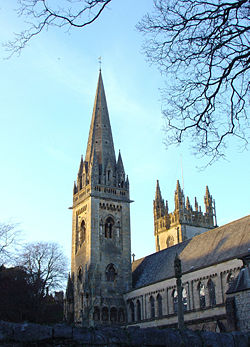Theosophical Society,
Cardiff Lodge,
Llandaff Cathedral

Llandaff Cathedral
Llandaff Cathedral is the seat of the Bishop of Llandaff (of the Church in
There is
evidence for Celtic Christian worship on the site the cathedral from the 6th
century and the original church is said to have been built by Saint Teilo on the bank of the River Taff
in 560. After his death, his shrine became a place of pilgrimage. The monastic
settlement survived for many centuries before the establishment of the diocese
of Llandaff at some point shortly after 1020.
The
Damage was
done to the church in 1400, during the rebellion of Owain
Glyndŵr, and his forces destroyed the Bishop's
Palace at Llandaff. However, most of the other damage
was repaired notably by Bishop Marshall whose reredos
partly survives, and the north-east tower (the one without a spire) was added
by Jasper Tudor, and is now named after him. He assumed the lordship of
During the
English Civil War, the cathedral was overrun by Parliamentarian troops, and by
1720 the southwest tower was in a state of collapse. In 1734, work began on a
new cathedral, nicknamed the "
During the
19th century, when the Bishop of Llandaff began, for
the first time for centuries, to reside in Llandaff,
the cathedral was extensively restored, the tower rebuilt and a spire added. A
triptych by Dante Gabriel Rossetti was designed for
use as a reredos, and new stained glass windows were
designed by Sir Edward Burne-Jones and Ford Madox
Brown.
The cathedral
school which existed from the time of the Elizabethan Bishop Blethyn until about 1700 was re-established by Dean Vaughan
in 1880.
On the
evening of
Major
restorations and reconfigurations were carried out under architect George Pace
of
The Queen
attended a service celebrating the completion of the restoration on August 6,
1960. The Welch Regiment memorial chapel was constructed, and Sir Jacob Epstein
created the figure of Christ in Majesty which is suspended above the nave on a
concrete arch designed by George Pace.
In February
2007 the cathedral suffered a severe lightning strike. Particular damage was
caused to the electrics of the organ, which was already in poor condition. This
prompted the launch, on
The cathedral
has the traditional Anglican choir of boys and men, with the only dedicated
choir school in the Church in
A One Minute History of Cardiff
Theosophical Society,
For more info on Theosophy
Try these
Dave’s
Streetwise Theosophy Boards
This
is for everybody not just people in Wales
Cardiff Lodge’s Instant Guide to Theosophy
One Liners & Quick Explanations
The Most Basic Theosophy Website in the Universe
If you run a
Theosophy Group you can use
this as an
introductory handout
The
South of Heaven Guide to
Theosophy and Devachan
The Spiritual Home of Urban Theosophy
The Earth Base for Evolutionary Theosophy
Try these if you are looking
for a
local Theosophy Group or Centre
UK Listing of Theosophical Groups
Worldwide Directory of Theosophical Links